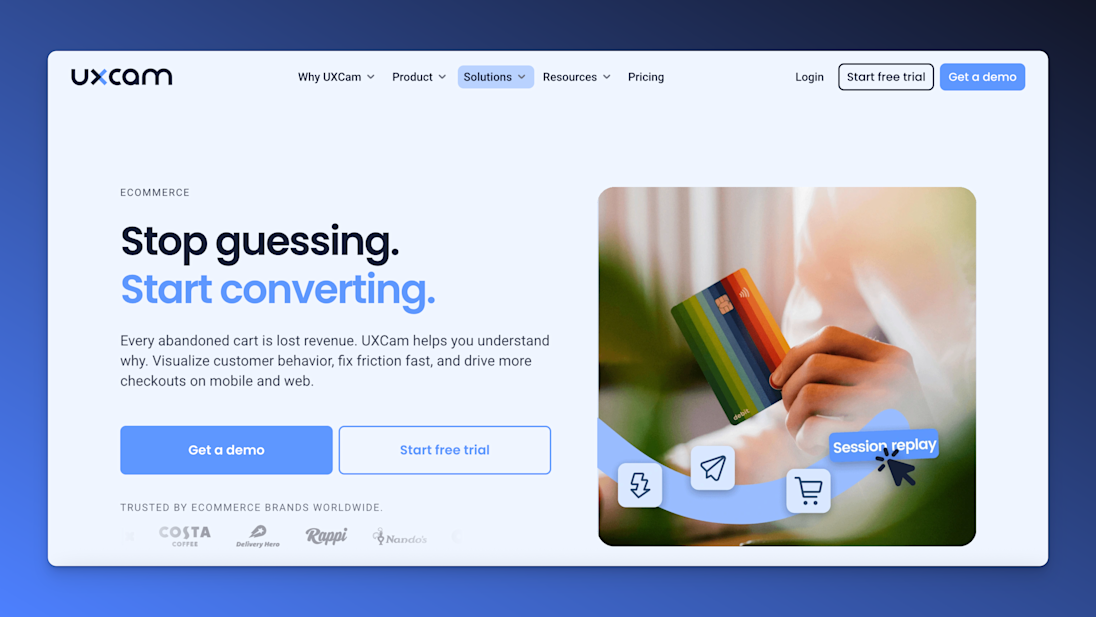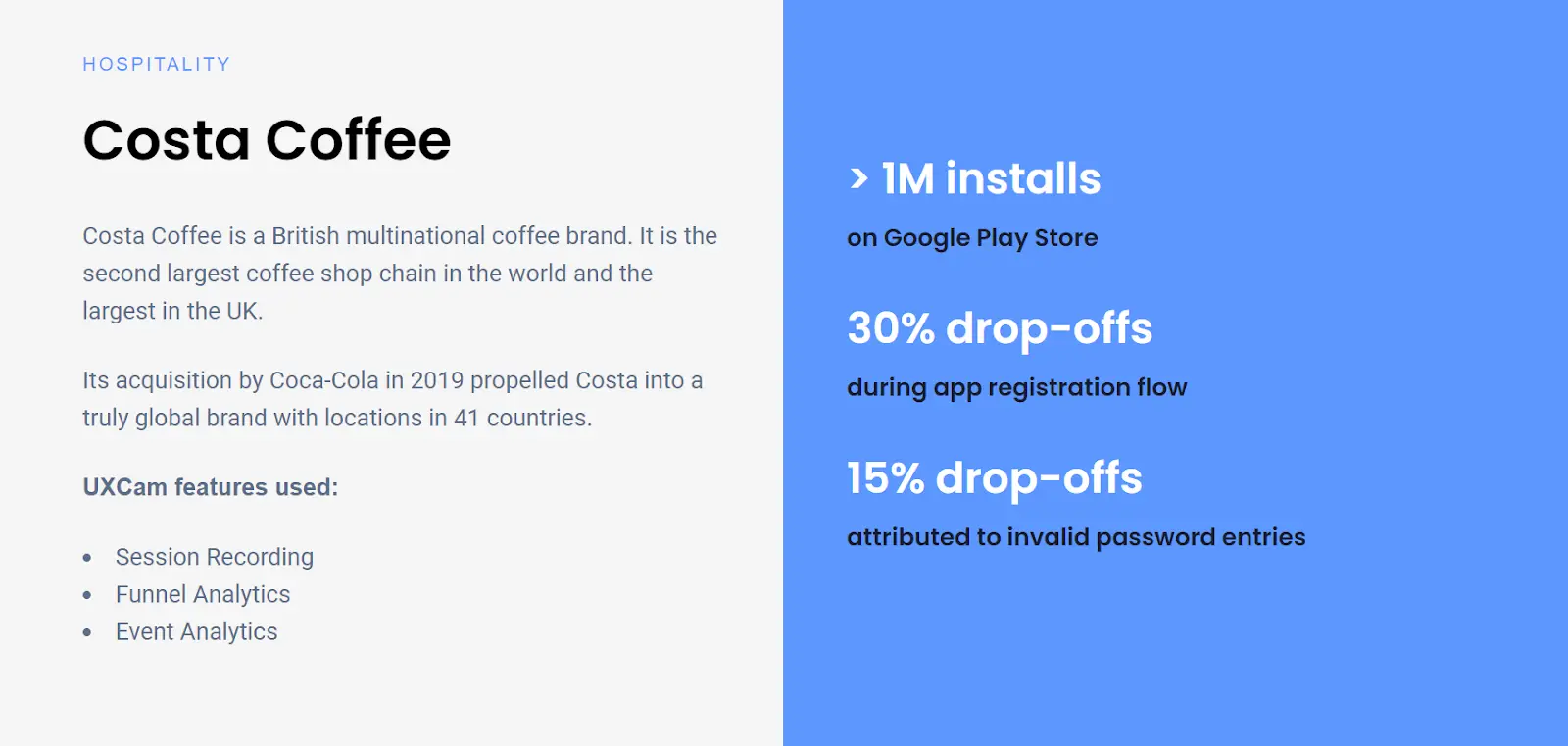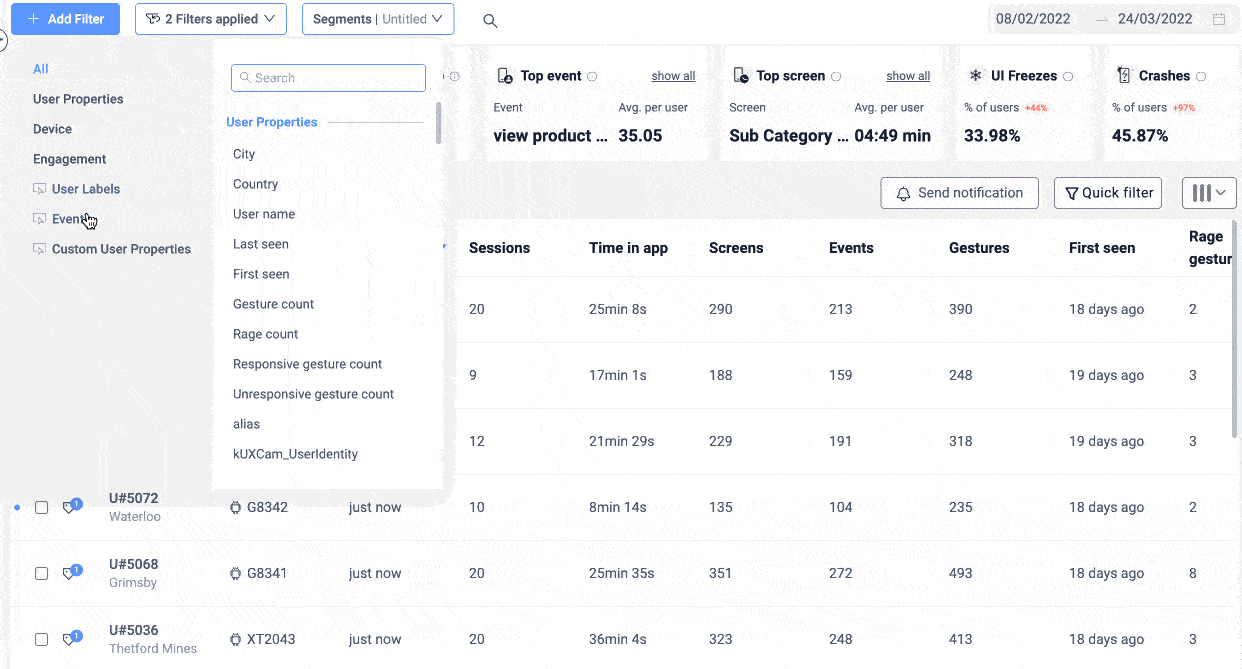Back to blog
6 MIN READ
5 Effective Strategies to Reduce Customer Churn
PUBLISHED
18 December, 2023

Product Analytics Expert
In an ideal world, everyone who installed your app would stay active and loyal for life. Unfortunately, customer churn happens—it’s the reality of any business, big or small. But that doesn’t mean you can't do anything about it.
At UXCam, we help product teams make data-driven decisions that effectively reduce user churn and improve UX. In this guide, we break down five of the most effective strategies you can use to reduce customer churn and retain more users.
Let’s dive in.
What is customer churn?
Customer churn (usually measured as churn rate) is a product metric used to measure the number of customers who are no longer using your product or service. It’s often expressed as a percentage—for example, if 10 out of 100 customers stopped using your product in a given month, then you would have a churn rate of 10%.
There are tons of reason why customers churn, including:
Lack of engagement
Missing or flawed features
Bad customer service
The key is finding out which reasons apply to your product.
To do that, a product analytics tool like UXCam is incredibly helpful. You can monitor churn over time through user behavior monitoring and zero in on root causes using tools like heatmaps, session replays, event logs, and issue analytics.


How to reduce customer churn
Understand why customers leave
Improve the onboarding process
Build customer loyalty
Build meaningful customer segments
Recover failed payment
Step 1 - Understand why customers leave
Every customer leaves for a reason (sometimes multiple).
In some cases, these reasons are beyond your control—like a customer's budget or changed circumstances. But in many cases, it’s something you can fix. Researching why customers stop using your product will help you determine the best strategies to reduce churn and retain your existing users.
There are a few tools you can use to get to the bottom of why customers leave:
Exit surveys: Ask departing customers why they've decided to leave.
Customer feedback channels: Monitor user feedback on social media, email, and other channels for customer sentiment over time.
Analytics: Analyze usage and customer behavior data to identify trends.
On the analytics front, UXCam can help.
You can easily create segments for churned users and zoom in on behavioral patterns and individual experiences to infer what led to the churn. For example, Costa Coffee was struggling with churn after launching their loyalty program. They isolated churned sessions, zoomed in with session replays, and found that their overly complicated “forgot password” flow was scaring users away.

You can also use UXCam’s funnel analytics feature to analyze user drop-off points, identify where customers may have had difficulty or encountered errors, and generate ideas for how to improve their experience.
Step 2 - Improve the onboarding process
Onboarding is a major source of avoidable customer churn for many of the businesses we work with.
Users are entering your product for the first time, so you need to make sure they understand how to use it quickly and easily. If there are any confusing steps or features, you risk losing them forever.
The solution? Build user-centric onboarding flows that guide users to the value you provide. Tools like Appcues and Product Fruits offer features like tours, tooltips, checklists, and more that make the process more fun and impactful.
In addition, you should be carefully monitoring your onboarding flow(s) using a monitoring tool like UXCam. Track completion rates and the impact that completing the onboarding flow has on product usage and churn. If you aren’t seeing results, something needs to change.
Step 3 - Build customer loyalty
Engagement is key when it comes to building long-term customer loyalty. You need to figure out why your customers are staying and what keeps them coming back for more. Offer rewards, incentives, and loyalty programs that keep your customers feeling valued and appreciated.
Also, aim to keep your brand top-of-mind (without being annoying) by:
Sending regular push notifications
Implementing a usage streak system
Building a community
Offering content upgrades and exclusive promotions
And finally, don’t forget about personalization!
Personalize messages and experiences based on user data like demographics, location, interactions with the product, or even past purchases. Taking the time to get to know your users will go a long way in creating an emotional connection between you and them.
Step 4 - Build meaningful customer segments
Different customer segments may have different reasons for churning. By segmenting your customers and analyzing churn within each segment, you can tailor your retention strategies to each group’s specific needs.
For example, you might discover that users on your Pro plan are churning due to pricing concerns, while users on your Basic plan are churning due to slow customer support. This finding not only allows you to address the correct concerns, but also prioritize issues that align with business goals.
UXCam’s segmentation feature is invaluable here.

It allows you to segment all in-app data by any trait and characteristic, or rely on pre-built segments for quick insights. You can save important segments for future analysis and apply them to any chart, table, or data set in the platform.
Step 5 - Recover failed payment
Failed payments can lead to involuntary churn. Implementing a robust dunning process can help recover failed payments and reduce churn.
A dunning process involves making multiple attempts to collect payment from a customer whose initial payment has failed. This can include sending automated emails, making phone calls, and using other communication channels to remind the customer about the failed payment and provide instructions for updating their payment information.
By implementing an effective dunning process, you can increase the chances of recovering failed payments and retaining customers who may otherwise churn due to payment issues.
Once the payment is successfully recovered, provide customers with receipts. You can create them using tools like Zintego receipt maker ensuring customers receive confirmation. Also, make sure to maintain a record for your reference, preventing unnecessary reminders in the future.
Why is reducing customer churn important?
Sustainable business growth
Churn directly influences a mobile app's ability to achieve sustainable growth.
The worldwide app retention rate in 2019 was a mere 32%, with a staggering 25% of users abandoning an app after just one use. Building a stable user base becomes challenging when users consistently uninstall the app—and that leads to lower revenue, LTV, and ARPU.
Cost-effectiveness
Monitoring and reducing churn prove to be more cost-effective than perpetually acquiring new users. Acquiring a new user is 5-25X more expensive than retaining an existing one. This cost disparity underscores the importance of investing efforts in retaining users through strategic initiatives.
Statusbrew's attempts to reduce churn by 20% through customer engagement strategies provide a tangible example of the cost-effectiveness of retention over continuous user acquisition.
Understanding user behavior and preferences
Churn analysis plays a pivotal role in understanding where and why users are dropping off. This insight allows app developers to make informed improvements in user experience and engagement. Common reasons for uninstalls include lack of use, device storage issues, or excessive advertising
Maintaining competitive advantage
High churn rates can signal a potential decline in a competitive market. By monitoring churn, app developers can stay abreast of market trends and user expectations, ensuring they stay competitive. This involves attracting new users and retaining and satisfying the existing ones.
Companies like Chick-fil-A, CVS, and Starbucks have successfully implemented strategies like rewarding engagement, providing a streamlined platform, and incorporating gamification to maintain user interest and reduce churn.
Conclusion
Churn reduction is a complex process that involves knowing your customers' needs and behaviors well. Some of the key strategies are enhancing customer service, customizing user experiences, and using data analytics to identify and avoid churn. Asking for feedback regularly and implementing it can also boost customer retention.
Keep in mind that every interaction with a customer is a chance to understand them better and deliver value. By prioritizing building strong relationships with your customers, you can reduce churn and make your customers promoters of your brand.
Want to take your user experience to the next level? Try UXCam for free and gain a better understanding of your users. UXCam gives you the tools and insights you need to reduce churn and increase customer loyalty through data-driven development.
You might also be interested in these;
How to measure, analyze, and reduce app churn
How to increase mobile app retention: ultimate guide
Mobile app retention benchmarks by industries
AUTHOR

Tope Longe
Product Analytics Expert
Ardent technophile exploring the world of mobile app product management at UXCam.
What’s UXCam?
Related articles
Session Replay
Mobile Session Recording - The Complete Guide 2026
Why session replay is such a valuable feature, and what you should look out for when starting...

Annemarie Bufe
Product Analytics Expert
Product Management
14 Best Product Development Software for Every Team 2025
Discover the 14 best product development software tools to streamline collaboration, track progress, collect feedback, and build better products...

Tope Longe
Product Analytics Expert
Product Management
13 Best Product Management Tools 2025 & When to Use Them
Find out the top tools that the best product managers use daily to perform better at...

Jane Leung
Product Analytics Expert
